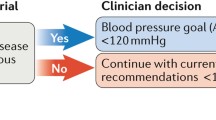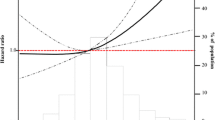Abstract
The SPRINT study investigators used the un-observed automated office blood pressure measurement technique. When their achieved systolic blood pressure is corrected, target systolic blood pressure for most people remains unchanged: <140mmHg for prevention of cardiovascular diseases and death.
Similar content being viewed by others
References
Ambrosius WT, Sink KM, Foy CG, et al. The design and rationale of a multicenter clinical trial comparing two strategies for control of systolic blood pressure: The Systolic Blood Pressure Intervention Trial (SPRINT). Clinical Trials. 2014;11:532–46.
The SPRINT Research Group. A randomized trial of intensive versus standard blood-pressure control. N Engl J Med. 2015;373:2103–16.
Schiffrin EL, Calhoun DA, Flack JM. SPRINT proves that lower is better for non-diabetic high-risk patients, but at a price. Am J Hypertens. 2016;29:2–4.
Myers MG, Godwin M, Daves M, et al. Measurement of blood pressure in the office: recognizing the problem and proposing the solution. Hypertension. 2010;55:195–200.
Drawz PE, Pajewski NM, Bates JT, et al. Effect of intensive versus standard clinic-based hypertension management on ambulatory blood pressure. Results from the SPRINT (systolic blood pressure intervention trial) ambulatory blood pressure study. Hypertension. 2017;69:00–00. doi:10.1161/HYPERTENSIONAHA.116.08076.).
Filipovský J, Seidlerová J, Kratochvíl Z, et al. Automated compared to manual office blood pressure and to home blood pressure in hypertensive patients. Blood Press. 2016;25:228–34.
Lund-Johansen P. Hemodynamics in early essential hypertension (table 23, page 43). Acta Medica Scand. 1967;181(Suppl.482):2–101.
Mancia G, Bertinieri G, Grassi G, et al. Effects of blood pressure measurements by the doctor on the patientʼs blood pressure and heart rate. Lancet. 1983;2:695–8.
Mancia G, Parati G, Pomidossi G, et al. Alerting reaction and rise in blood pressure during measurement by physician and nurse. Hypertension. 1987;9:209–15.
Parati G, Pomidossi G, Casadei R, Mancia G. Lack of alerting reactions to intermittent cuff inflations during noninvasive blood pressure monitoring. Hypertension. 1985;7:597–601.
Kjeldsen SE, Lund-Johansen P, Nilsson P, Mancia G. Unattended blood pressure measurements in the systolic blood pressure intervention trial. Implications for entry and achieved blood pressure values compared with other trials. Hypertension. 2016;67:808–12.
Kjeldsen SE, Hedner T, Jamerson K, et al. Hypertension optimal treatment (HOT) study: home blood pressures in treated hypertensive subjects. Hypertension. 1998;31:1014–20.
Author information
Authors and Affiliations
Corresponding author
Ethics declarations
Conflict of Interest
Dr. Kjeldsen has received modest honoraria for consultancy and lecturing from ABDiiBRAHiM, Bayer, Merck, and Takeda. Dr. Mancia declares no conflicts of interest relevant to this manuscript.
Human and Animal Rights and Informed Consent
This article does not contain any studies with human or animal subjects performed by any of the authors.
Rights and permissions
About this article
Cite this article
Kjeldsen, S.E., Mancia, G. The Un-Observed Automated Office Blood Pressure Measurement Technique Used in the SPRINT Study Points to a Standard Target Office Systolic Blood Pressure <140 mmHg. Curr Hypertens Rep 19, 3 (2017). https://doi.org/10.1007/s11906-017-0700-y
Published:
DOI: https://doi.org/10.1007/s11906-017-0700-y




